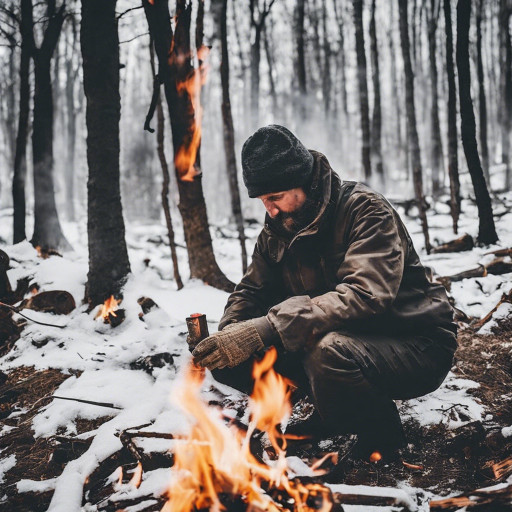Master Core Fire-Starting Techniques to Thrive in Frigid Environments
Starting a fire in cold temperatures goes beyond being a mere skill; it is a vital survival tactic that becomes increasingly critical as winter approaches, with its harsh cold and unyielding winds. As an avid survivalist, you recognize that fire is indispensable for maintaining body warmth, providing light, and preparing meals. However, successfully igniting a flame in icy conditions presents distinct challenges that demand specific techniques and strategies. This detailed guide will explore the most effective and reliable methods for creating fire during cold weather, empowering you with the essential knowledge and skills required to conquer winter’s frigid grasp and flourish in the wilderness.
Gather the Right Gear for Successful Fire Starting in Winter
Before embarking on your winter wilderness adventures, it is crucial to equip yourself with the right gear and supplies that can significantly enhance your chances of survival in adverse conditions. A well-stocked fire-starting kit can be the difference between a warm night and a perilous situation. Your kit should include several critical items:

a. Firestarters: Essential tools such as waterproof matches, storm-resistant lighters, and fire-starting rods are critical for ensuring ignition, even amidst challenging conditions like high winds and dampness. Having a variety of options at your fingertips will greatly bolster your confidence to start a fire, regardless of the obstacles you may face.
b. Dry Tinder: Locating dry tinder in frigid temperatures can prove to be a daunting task. To effectively address this challenge, bring along highly flammable materials such as birch bark, fatwood shavings, and cotton balls soaked in petroleum jelly. These materials ignite quickly and significantly enhance your chances of successfully starting a fire when temperatures plunge below freezing, providing a crucial advantage when it matters most.
c. Kindling: To create a robust base for your fire, gather dry sticks, twigs, and leaves. It is vital to ensure that these materials are completely dry, as any moisture can hinder the ignition process, leading to frustration when attempting to spark a flame. Properly prepared kindling is essential for transitioning from tinder to a stronger fire, allowing you to effectively sustain heat and warmth.
d. Fuel: Securing dry firewood in freezing temperatures can be both exhausting and time-consuming. Therefore, it is essential to have a sufficient stock of dry firewood prepared ahead of time. This foresight enables you to maintain a steady fire for an extended period, ensuring you remain warm and can cook food comfortably without unnecessary interruptions.
Select the Best Location for Your Fire to Maximize Efficiency
When temperatures plummet, choosing the ideal location for your fire can provide substantial benefits. Seek sheltered spots such as rock formations or dense shrubs to shield yourself from harsh winds. By positioning your fire near a natural windbreak, you reduce heat loss and significantly increase the likelihood of maintaining a steady flame. Additionally, consider building a small wind-resistant shelter using logs or a tarp to protect the fire from precipitation, thereby helping to retain warmth. This thoughtful strategy enhances your comfort and safety while enjoying the great outdoors.
Implement the Layering Technique for Sustainable and Effective Fires
An essential skill for successfully igniting a fire in cold conditions is mastering the art of layering your materials effectively. To establish a fire that burns steadily, it is crucial to utilize the three foundational layers: tinder, kindling, and fuel. Here’s a detailed exploration of each layer and its significance:
a. Tinder: The first layer, known as tinder, comprises materials that ignite quickly and easily. Use fine, dry substances like grass, paper, or the aforementioned birch bark to ensure a powerful initial flame. Having an adequate quantity of tinder is vital for achieving successful ignition, especially in cold environments where conditions can be particularly challenging.
b. Kindling: This layer consists of small sticks and twigs that catch fire rapidly and provide sustained heat. Gradually add kindling to your flame, ensuring ample space between pieces to promote airflow and encourage combustion. This step is crucial for transitioning from small flames to a larger, more stable fire, ensuring your warmth is maintained.
c. Fuel: Once a steady flame has been established, gradually introduce larger pieces of firewood. Ensure the wood is dry, as it will burn longer and generate more heat. Increase the size of the wood pieces incrementally, allowing the flames to grow stronger before adding larger logs. This strategic approach to layering your fire facilitates a stable and sustainable flame, which is essential for your survival in cold conditions.
The technique of layering your fire creates a structured setup that allows the flames to expand and sustain themselves efficiently. Always ensure you have an adequate supply of each component readily available to facilitate a smooth transition from tinder to fuel, which is crucial for ensuring a successful fire under challenging circumstances.
Boost Your Fire-Starting Success with Proven Aids and Techniques
In extremely cold weather, utilizing additional fire-starting aids can significantly enhance your chances of successfully igniting a fire against the challenges posed by low temperatures. Here are several effective methods to consider:
a. Fatwood: Often called nature’s firestarter, fatwood is resin-infused pine wood that ignites easily and burns with intense heat. You can gather these naturally occurring sticks from fallen pine trees or purchase them at outdoor supply stores. Just a few pieces of fatwood can dramatically improve your odds of successfully starting a fire in exceptionally cold conditions, providing a dependable ignition source.
b. Alcohol-Based Hand Sanitizer: Surprisingly effective, alcohol-based hand sanitizer is highly flammable and serves as an excellent accelerant. A small amount applied to your tinder or kindling can help ignite a fire rapidly, even in damp conditions, streamlining the fire-starting process and ensuring you remain warm when it’s needed most.
c. Char Cloth: Char cloth is a specially prepared fabric that ignites easily from sparks, making it an excellent tool for starting fires using flint and steel or a lighter in challenging scenarios. Its lightweight and portable nature makes it an ideal addition to your fire-starting kit, ensuring you are always prepared for any situation that may arise.
Incorporating these fire-starting aids into your cold-weather toolkit can significantly enhance your chances of success when confronting particularly challenging conditions, allowing you to adapt effectively to the environment and maintain warmth.
Discover Effective Fire Techniques Tailored for Cold Weather Survival
As a dedicated survivalist, continually refining your skills is crucial to your success. Here are two fire-starting techniques that excel in cold weather conditions:
a. Swedish Torch: Also known as a Canadian Candle or Finnish Fire Log, the Swedish Torch is an exceptionally effective fire-starting method. This technique offers a stable and long-lasting flame, ideal for combating the chill of winter. To create a Swedish Torch, find a log approximately knee-height and cut several vertical slits along its length. Place tinder in the slits and ignite it. The log will serve as a consistent fuel source, allowing the flame to endure for an extended period, thus ensuring warmth and safety.
b. Dakota Fire Hole: When faced with strong winds, the Dakota Fire Hole method is highly effective. This technique involves digging a hole and tunneling horizontally underground to create an airflow vent. This design harnesses wind to enhance airflow, resulting in a more efficient fire that is less susceptible to disruption from gusts. Furthermore, the Dakota Fire Hole method effectively reduces visible smoke while conserving fuel, making it an excellent choice for discreet fire-building.
No matter which method you select, always prioritize safety and responsible fire management to minimize risks and ensure a successful fire-starting experience while enjoying the great outdoors.
Successfully igniting a fire in cold weather demands meticulous planning and execution. By following these comprehensive steps—preparing a reliable fire-starting kit, selecting an appropriate location, mastering layering techniques, utilizing fire-starting aids, and embracing specific fire strategies—you will significantly enhance your chances of success. Remember, practice makes perfect, so consistently train to refine your skills and boost your confidence. With these essential tactics for igniting fires in freezing conditions in your toolkit, you’ll be well-prepared to face even the harshest winters that nature has to offer. Stay warm, prioritize your safety, and keep the flames of survival alive!
The post Fire Starting Methods for Survivalists in Cold Weather appeared first on Survival Bite.
The Article Fire Starting Techniques for Cold Weather Survival Was Found On https://limitsofstrategy.com






Your insights on fire-starting in cold environments highlight such an essential survival skill. I remember a winter camping trip where I underestimated the difficulty of staying warm. I had a decent amount of gear, but it turned out that even a small amount of moisture on my matches made them nearly useless.
That sounds like quite the experience. It’s surprising how quickly things can go south when the weather turns. Even a little moisture can ruin your plans for a warm fire. I’ve had similar moments myself where I thought I was prepared but learned the hard way about the fragility of gear in cold, damp conditions.
Ah, the great outdoors in winter – a classic case of nature trying to prove who’s boss. Moisture on your matches? That’s like bringing a spoon to a knife fight. And it’s amazing how quickly those little sticks become your worst enemy when the temperature drops.
This post resonates deeply with anyone who has ventured into the wilderness during winter, where the stark beauty of a snow-capped landscape belies the myriad challenges it presents. Fire, as you emphasized, is not merely a tool for survival but an elemental cornerstone of the human experience. It symbolizes warmth, safety, and the gathering of communities—something I believe we often take for granted in our modern lives, where heat and light are just a flick of a switch away.